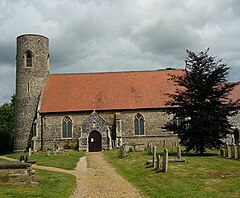Belton with Browston
| Belton with Browston | |
|---|---|
 Belton's medieval church |
|
| Belton with Browston shown within Norfolk | |
| Area | 8.36 km2 (3.23 sq mi) |
| Population | 3,805 (2011) |
| • Density | 455/km2 (1,180/sq mi) |
| OS grid reference | TG 481 029 |
| Civil parish |
|
| District | |
| Shire county | |
| Region | |
| Country | England |
| Sovereign state | United Kingdom |
| Post town | GREAT YARMOUTH |
| Postcode district | NR31 |
| Dialling code | 01493 78 |
| Police | Norfolk |
| Fire | Norfolk |
| Ambulance | East of England |
| EU Parliament | East of England |
Belton with Browston is a civil parish in the English county of Norfolk. The parish consists of the villages of Belton and Browston Green, and is situated some 5 miles (8 km) south-west of the town of Great Yarmouth and 6¼ miles (10 km) north-west of the Suffolk town of Lowestoft.
The civil parish has an area of 3.23 square miles (8.36 square km) and in the 2001 census had a population of 4,098 in 1,589 households, the population reducing to 3,805 at the 2011 Census. For the purposes of local government, the parish today falls within the district of Great Yarmouth. However prior to the Local Government Act 1972, the parish was within Lothingland Rural District in Suffolk. It is connected to Yarmouth by bus services 6B and 7 and to Norwich by the X11 service, operated by First Norfolk & Suffolk.
The earliest evidence of human inhabitation is a flint axehead from the Palaeolithic period. The fort at nearby Burgh Castle along with finds of coins and pottery indicate that the area was inhabited throughout the Roman Britain period.
Belton (as Beletun) and Browston (as Brockestuna) are both mentioned in Domesday book, published after the Norman Invasion of 1066. The population was probably around 50-60 in each of the villages.
During the medieval period, Belton and Browston were essentially agricultural communities and evidence has indicated that Browston could have been the larger of the two during this time. There is no mention of a church in Belton at the time of Domesday book. The earliest record of the church is in the time of Henry I who ruled from 1100-1135. Judging by architectural style, the current church building dates form the 1300s with major restoration work taking place from 1837 Rev Revd Francis Howes and his family. The tower was rebuilt in 1849.
...
Wikipedia

